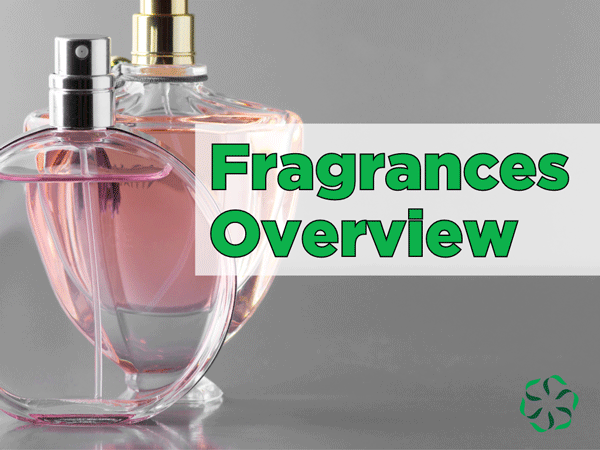In this series, we look at the fragrances we encounter in our everyday lives. In this post, we take a general look at fragrances.
What is a fragrance?
Fragrances are substances possessing strong-smelling organic compounds that have characteristic, pleasant odors. Manufacturers use them in many products as a perfume.
Sometimes a fragrance ingredient can be a flavor ingredient because flavors and fragrances use similar chemical messengers in our body. While the same scent or plant may be used in a product, flavors may be processed differently for purity and will be labeled and are regulated differently than a fragrance (1).
Where do we encounter fragrances?
We find fragrances in the majority of cosmetics, toiletries, household, laundry, air fresheners, candles, and incense products we use frequently.
They are part of the products in our everyday life unless we actively avoid fragranced products (1,2).
How are fragrances created?
Much like flavors, manufacturers derive fragrances from natural and synthetic methods.
Natural compounds are derived from natural sources (often plants) by physical or biotechnological procedures to harness the ingredients.
Synthetic fragrance ingredients can either be nature-identical or artificial. Natural-identical synthetic fragrances are made from synthetically derived ingredients to have the same chemical composition as a fragrance found in nature. Artificial fragrances are made from synthetic ingredients and have a scent and/or chemical composition not known to be found in nature (1).
Five classes of compounds make up most fragrance ingredients:
- Alcohols
- Aldehydes
- Ketones
- Esters
- Lactones
There are thousands of registered fragrance ingredients made from these compounds (1,2,3,4).
Are they regulated?
The U.S. Food and Drug Administration (FDA) regulates fragrance ingredients as cosmetics if they are in a cosmetic product and function to provide scent. The FDA does not approve or test cosmetic products, including fragrances, before they are available for sale. Manufacturers are legally responsible for ensuring product safety when we use the products as intended. If there is a safety issue, the FDA can and will test products and issue recalls when necessary (1,2).
Other fragrance ingredients may be treated as drugs by the FDA if the manufacturer intends for the ingredients to treat a condition. For example, “easing muscle aches” would cause the FDA to treat a fragrance-containing product as an over-the-counter drug, meaning it’s governed by the same FDA rules and regulations applicable to any over-the-counter pharmaceutical medications (1,2).
Scents containing products that are not applied directly to the body, such as laundry detergents, fabric softeners, room fresheners, and more, are regulated by the Consumer Product Safety Commission (CPSC).
The CPSC is responsible for creating voluntary standards, issuing and enforcing mandatory standards, and recalling and potentially banning products that can cause us harm (1).
Like the FDA and cosmetic ingredients, products are not required to have premarket approval before being sold to the public. However, manufacturers are legally responsible for ensuring product safety, so the CPSC can issue recalls or ban products containing ingredients known to cause harm.
Do other organizations monitor fragrances
Yes, The International Fragrance Association (IFRA) and The Research Institute for Fragrance Materials (RIFM) are organizations that support manufacturers and researchers globally on fragrance and fragrance safety.
IFRA contains a list of fragrance ingredients, and RIFM explores the ingredients’ safety profiles. Again, the manufacturers are responsible for ensuring the fragrance ingredients are safe.
Are they safe?
Manufacturers cannot sell products that cause harm making fragrances safe for most individuals (1,2).
However, some fragrances might contain ingredients that could cause allergic reactions including asthma, allergies, migraines, and contact dermatitis in sensitive populations (1,2).
If you have sensitive skin or have other health sensitivities, it’s important to work with your physician to learn your triggers and avoid fragranced products when needed.
There are reports raising concerns about some fragrance ingredients, especially phthalate ingredients. Research does not show that exposure to a limited amount of phthalate ingredients, including fragrance ingredients, will cause harm (1,2).
As we have discussed in previous blogs (1,2,3), a hazard is not a risk if people are not exposed to a hazard at harmful levels. As with most ingredients, the dose makes the poison. If you’re ingesting, using, or coming into contact with a harmful phthalate, in large enough qualities an adverse health effect could result. However, known harmful phthalates are not permitted for use and are not found in new products or fragrance products (1,2).
As with all science, our understanding evolves as scientists and manufacturers conduct more research. We will continue to monitor academic discourse around this area and update our content if a significant change occurs.
The good news.
We’ve used fragrances for millennia. Now, we have the technology to harness scents in ways never before possible and to explore the safety both long and short term of these ingredients. As our technology continues to develop, we can expect to see more and different types of fragrance ingredients available to us.

